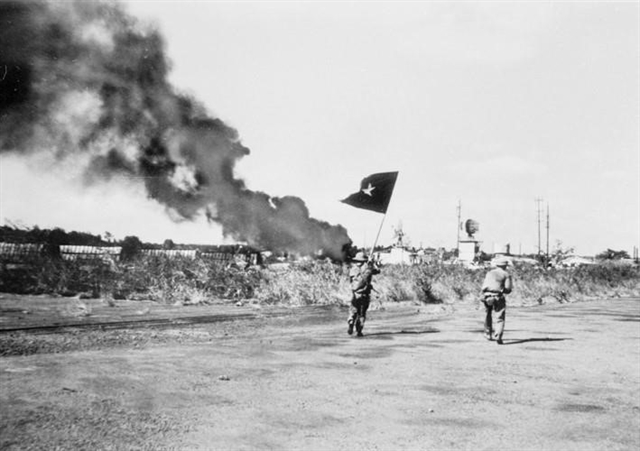 Society
Society

In the spring-summer of 1975, the Việt Nam’s Central Military Commission launched the Tây Nguyên (Central Highlands) Campaign, coded A275. It aims to wipe out an important part of enemies and liberate Đắk Lắk, Phú Bổn, Quảng Đức provinces.

|
| Our forces conducted a raid at Hòa Bình Airport in Buôn Ma Thuột. — VNA File Photos |
CENTRAL HIGHLANDS — In the spring-summer of 1975, Việt Nam’s Central Military Commission launched the Tây Nguyên (Central Highlands) Campaign, codenamed A275.
It aim was to wipe out an important part of the enemy and liberate Đắk Lắk, Phú Bổn, Quảng Đức provinces.
The decision to launch the campaign was an important one to make because the move was a precursor for the General Offensive and Uprising in the spring of 1975 that led to southern Việt Nam's liberation and the country's reunification.
The campaign lasted between March 04 and April 03.
The Central Highlands region of Việt Nam then covered an area of about 60,000 sq.m and consisted of Kon Tum, Pleiku, Phú Bổn, Đắk Lắk provinces and a section of Quảng Đức Province.
It was called the ‘roof of Indo-China’ by the French because of its important strategic location. The enemy had turned the region into a large strategic military base with the aim of wiping out the resistance of the Indo-China nations, preventing our forces from transporting humans and logistics from the north to the south and from the mountainous areas to the plain areas of Zone 5.
The campaign commander was Lieutenant General Hoàng Minh Thảo and the political commissar was Senior Colonel Đặng Vũ Hiệp.
The participating units included five infantry divisions, four independent artillery regiments, battalions, anti-air artillery regiments, engineering regiments and others.
From March 4 to 9, our forces cut off the enemy’s transportation routes on roads No 19 and 21, isolated Central Highlands from the central coastal area and separated Road No 14 to isolate the Northern Central Highlands from the Southern Central Highlands.
Then we attacked and occupied Thuần Mẫn District on March 8, Đức Lập District on March 9 and completely surrounded Buôn Ma Thuột.
On March 10 and 11, our forces attacked Buôn Ma Thuột Town and won the first key battle of the campaign.
In five days between March 14 and 18, our forces smashed a large-scale counteroffensive of the enemy Division 23 in Nông Trại-Chư Cúc, the second key battle of the campaign.
Suffering heavy losses and facing our forces’ strong operations, on March 15, enemy forces fled from Kon Tum and Pleiku, following Road 7, with the aim of gathering forces in the coastal plain areas of Military Zone 5.
Sensing an opportunity, our forces launched raids and annihilated most of fleeing enemy on Road 7 in Cheo Reo from March 17 to 19 and Cung Sơn on March 24, winning the third key victory.
Our forces then moved to coastal plains and co-ordinated with local military and people to liberate the provinces of Phú Yên and Khánh Hòa, ending the campaign on April 3, 1975.
After 31 days and nights of battle, our forces smashed enemy Army Group 2 in Military Zone 2, put out of action more than 28,000 enemy troops, captured and destroyed 154 aircraft and 1,096 military vehicles.
We also liberated five provinces of Kon Tum, Gia Lai, Đắk Lắk, Phú Bổn, Quảng Đức, and some coastal south-central provinces.

|
| A Vietnamese tank attacked Buôn Ma Thuột Town during the Central Highlands Campaign on March 10, 1975. |
Military arts
The glorious victory of the Central Highlands Campaign demonstrated the Party's wise directions, in particular, the guidance of the Politburo and the Central Military Commission in selecting the battlefield, timing and selecting key positions to attack.
The resounding victory saw new developments in the military arts of our forces, especially the art of distrusting the enemy. This is an extremely valuable historical experience that needs to be further researched, applied and developed in the period of national construction and defence.
Plotting, starting a battle and choosing a target (direction) are the outstanding developments of military arts in this campaign.
We chose the main target (Buôn Ma Thuột) which was the key but also weak position of the enemy. Our forces surprised the enemy by conducting secret raids in the southern Central Highlands instead of the north. It was called the diversion.
While one unit contained a large number of enemy troops in the northern Central Highlands, our major regular force launched large operations in the south Central Highlands.
We also cut off enemy units and isolated them. Using this opportunity, we conducted raids and attacked in force, leading the enemy to go into a strategic meltdown. — VNS